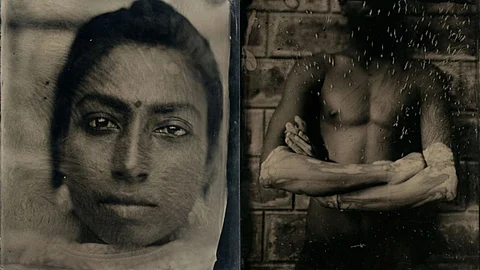
- HOMEGROWN WORLD
- #HGCREATORS
- #HGEXPLORE
- #HGVOICES
- #HGSHOP
- CAREERS
- ABOUT US
- CONTACT US

Do you know how much a fairness cream conglomerate makes annually in India? It is roughly ₹4,100 crores. These numbers are definitely something and they speak volumes about the obsession of Indians with fair skin. Today we are going to look at the photo series FAIRER PEOPLE = BEAUTIFUL PEOPLE = POWERFUL PEOPLE by the eminent Indian photographer, Arpan Mukherjee, and how he conducted a social experiment and used ‘alternative photography’ to capture the Indian infatuation with fair skin tone.
When he was a student of the visual arts, Arpan Mukherjee took up photography as his medium of expression. His works are based on socio-economic and political issues, and narratives in nature, and he represents them in documentary format. He believes the most important part of creation is the process of developing a body of work. He uses 19th-century photographic process to create. He is among the rare few artists who work with ‘alternative photography’ in the country and has developed mediums like gum dichromate, salt print, wet plate collodion, homemade silver gelatin emulation, etc, according to Indian climatic conditions. He has conducted extensive research on 19th-century photography methods and materials since 2001 and has incorporated them into the mainstream visual art stage. Arpan has received BFA & MFA in printmaking and presently teaching in the department of printmaking in VisvaBharati University, Santiniketan, West Bengal.
During the development of the photo series, he conducted a discussion session with a group of young people whose skin was dark in color. Most of these people were having insecurities about their dark complexion. For some of them, there was a stigma, starting from childhood, about their skin color. The discussion touched upon the use of fairness cream and the obsession with white skin in Indian society.
The responses from the discussion were interesting. Discrimination in terms of skin color still prevails in our country and most people think that it is derived from the nation’s colonial past. They also think that in our society it has a role in power dynamics, which results in discrimination. They think that there is a simple equation which is fairer people = beautiful people= powerful people. Some of them told that historically it has been denominated like that, and it is true that history has been crueler to people of darker skin shade. As a result, they all tried to be fairer at times. They also shared that most of them have used fairness cream but got disappointed. There were also some people who refused to take part in this discussion.
After the discussion was concluded, Mukherjee brought up the wet plate collodion process. It is the method that has been used in anthropological documentation of colonial India in the 19th century. He also informed the participants that the documentation process involved using iodides & bromides of silver which are not sensitive to red, and yellow but sensitive to blue and UV light—thus Indians having more red, and yellow hue skin, will be black in the photograph which they were are actually not.
The photographer explained the process and ask them how they wanted to be photographed in the wet plate collodion process. Some of them instantly opted for using instant whitening powder while some did nothing; some even applied Multani mitti. Mukherjee allowed them the freedom to choose how they wanted they wanted to be photographed to look more beautiful. Hearing so, some applied an excessive amount of talc to their faces. After that, began a long session where Mukherjee made ambrotype photographs with his 10” X12” wooden plate camera.
You can find out more about Arpan Mukherjee's works and studio here.
If you enjoyed reading this, we also suggest:
'I Don't Like Being Photographed': A Photoseries Exploring Body Shaming & Self-Acceptance
Chandigarh-Based Photographer Farheen Fatima Debuts A Retro-Esque Ode To Longing
Nelson Viji's Photographs Explore The Co-Existence Of The Sea And Humans In Puducherry
